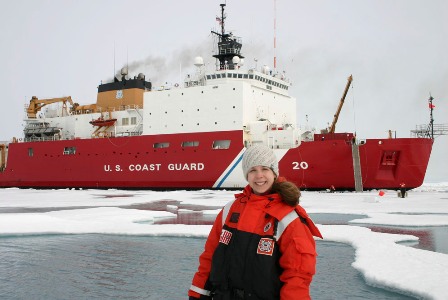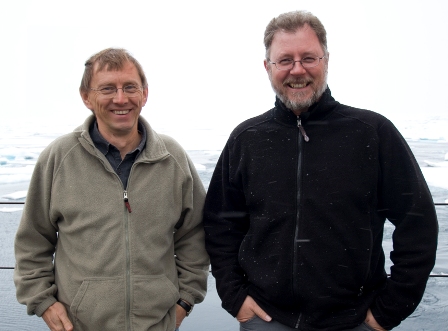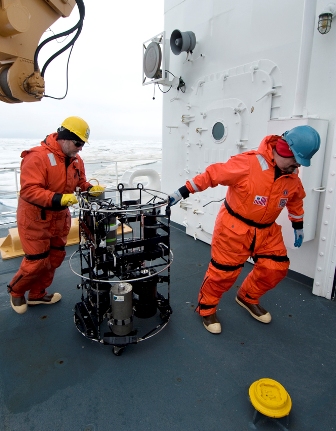From: Christie Wood, Clark University

Christie Wood (Photo by Molly Palmer)
It’s 9:15 a.m. and I’m still in bed sleeping because I worked late in the lab last night. An announcement awakens me over the loudspeaker: “On-Ice Brief on the bridge in 15 minutes!” I quickly roll out of bed and head upstairs to the bridge where several of my colleagues have been on the lookout for a good floe. The glare from the ice is almost blinding as I look out the window to see the chosen spot. They’ve managed to find a flat section of sea ice on a floe that is otherwise covered by rubble field. It’s a beautiful location covered with aqua colored melt ponds.
Once the entire ice team is present, we begin the “On-Ice Brief.” One of the Coast Guard crew reviews the rules and regulations for our on-ice deployment and then we discuss what the Coast Guard calls a GAR model in which both the Coast Guard and science team give their assessments of the risks involved with the day’s mission. They consider aspects such as supervision, crew fitness, environment and complexity. Once our plan for the day has been approved, we pack all of our gear onto sleds, grab a quick lunch, get suited up in our MSD 900 dry suits, put on our helmets, and head to the deck.
Don Perovich (affectionately known by many of the crew as “the Don” in reference to the The Godfather movie) accompanies the swimmer and swimmer tender onto the ice to make sure the area is safe. Don says, “It reminds me of Christmas. First the parents have to see if Santa was there and after that, the kids get to come out and enjoy all the presents.” Once we get approval from the bridge, the crew uses a crane to transport our gear filled sleds onto the ice, and then one-by-one we head down a very steep ramp called “the brow” onto the ice.
The ice in the Chukchi and Beaufort Seas is covered in melt ponds this time of year and one of my favorite parts of working on the ice is getting to explore them. When I reach into the pond to take a sample, I’m always amazed at how quickly my bottle hits the bottom. The bright aqua color of the ponds makes you think they are much deeper than a few inches. However, talking to Don Perovich and Bonnie Light at lunch one day, I learned that the color of a melt pond is not related to its depth but to the properties of the ice beneath it. As a result, when you walk across a shallow melt pond, it can look like you’re walking on water!
There are three teams of scientists looking at various properties of sea ice and the under ice water column, all hoping to gain a better understanding of the role of sea ice in the Arctic ecosystem. Each of the groups described below has a piece of the puzzle and by working together we can get a more complete picture of the complex interactions between light, sea ice, and biology. This will help us understand how changes in sea ice cover may affect the Arctic in the future.
Set Up
 Gear.JPG)
Gear transported to the ice. (Photo by Christie Wood)
 Scientists.JPG)
Scientists dressed in the required MSD 900s and helmets survey the location while waiting on deck for the equipment to go out onto the ice. (Photo by Kathryn Hansen)
 Sled_Kathryn.JPG)
Bonnie Light and Ruzica Dadic drag a sled full of equipment across a melt pond. (Photo by Kathryn Hansen)
 SetUp.JPG)
Scientists set up for a day of work on the ice. (Photo by Kathryn Hansen)
 Drilling.JPG)
Chris Polashenski and Benny Hopson drill a hole in the ice to be used by the different teams for water sampling and measuring light levels below the ice. (Photo by Kathryn Hansen)
Stanford University Group
While out on the ice, Kevin Arrigo, Matt Mills, and Zach Brown from Stanford University take ice cores and water samples from beneath the ice. They’ll bring these back to the lab to look at the biological activity of the sea ice. Of special interest are the ice algae, the small single-celled photosynthetic organisms that provide food for a wide variety of Arctic creatures.
 Matt_Zach.JPG)
Matt Mills and Zach Brown taking water samples. (Photo by Karen Romano Young)
 Matt_Zach2.jpg)
Matt Mills gets ready to cut a core into sections while Zach Brown holds the tarp up to block the sunlight. (Photo by Haley Smith Kingsland)
Clark University Group
Meanwhile, my group from Clark University sets up our optical equipment to examine how light varies with depth in the water under both bare and ponded ice. At the same time, I sample the water under the ice to understand how material in the water impacts the amount of light available for algae. We also measure oxygen isotopes (different forms of oxygen) to learn if the water is coming from terrestrial sources or sea ice melt. Finally, we examine ice cores taken from both the bare ice and the ice below the melt ponds to see how their thickness and composition affects the amount of light that reaches the underlying ocean.
 Karen_Luke.JPG)
Karen Frey lowers the optical profiler down through the water column below the ice while Luke Trusel monitors her speed and the tilt of the instrument on a laptop computer. (Photo by Christie Wood)
 Christie.jpg)
Christie Wood takes water samples from various depths below the ice. (Photo by Luke Trusel)
 Luke IcePro.jpg)
Luke Trusel stands in a melt pond next to the Icepod (a tripod containing two sensors one above and one directly below the ice that measure the amount of incoming light). (Photo by Karen Frey)
 Profileer.jpg)
The optical profiler goes down through the ice under the melt pond. (Photo by Luke Trusel)
 Karen_Christie.jpg)
Karen Frey and Christie Wood collect water samples from a melt pond. (Photo by Haley Smith Kingsland)
 Three Scientists.jpg)
Benny Hopson drills holes in the ice core for Karen Frey to take temperature measurements that Chris Polashenski records. (Photo by Haley Smith Kingsland)
CRREL & University of Washington Group
On another section, Bonnie Light and Ruzica Dadic measure light below both bare and ponded ice. They use a sensor attached to an arm that extends out under the ice and can be rotated to create a circular path. Among their many measurements, they look at the range of light that algae use during photosynthesis.
During much of our time on station, Don Perovich and Chris Polashenski can be seen roaming the perimeter of our site. When Chris isn’t drilling cores and auger holes, he’s venturing into the melt ponds surrounding our site hoping to learn how the underlying sea ice prevents ice melt water from draining into the ocean. Meanwhile, Don conducts surveys of ice thickness with an electromagnetic induction instrument, and he measures the amount of light reflecting off the ice surface.
Don is also known for his sweet tooth, and halfway through each station he comes around with a much-anticipated treat. The surprise Oreos, M&Ms, butterscotches, lemon drops, or root beer candies he brings taste a hundred times better than normal because we’ve been focusing on our work for so long!
 Ruzica.jpg)
Ruzica Dadic takes optical measurements under the white ice and melt pond. (Photo by Kathryn Hansen)
 Bonnie Light.JPG)
Bonnie Light logs the spectral data on her laptop computer. (Photo by Kathryn Hansen)
 Don.JPG)
Don Perovich conducts a survey of ice thickness using an electromagnetic induction
instrument. (Photo by Christie Wood)
 Don Candy.JPG)
Don Perovich surprises Haley Kingsland with candy. (Photo by Karen Romano Young)

 Matt_Zach2.jpg)
 Christie.jpg)
 Luke IcePro.jpg)
 Profileer.jpg)
 Karen_Christie.jpg)
 Three Scientists.jpg)
 Ruzica.jpg)










